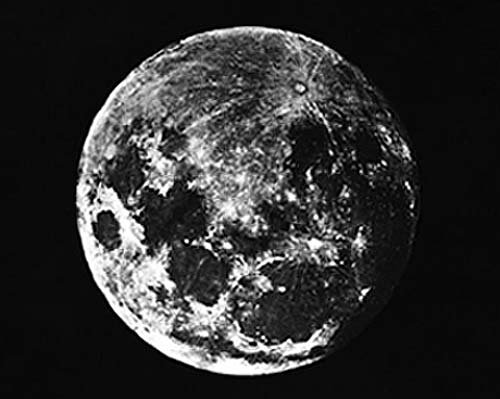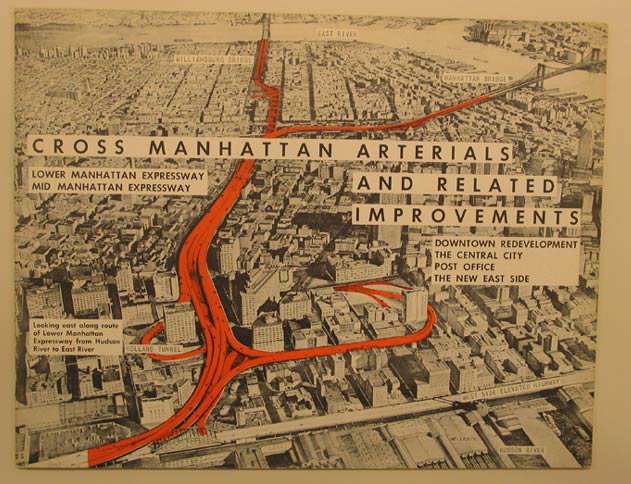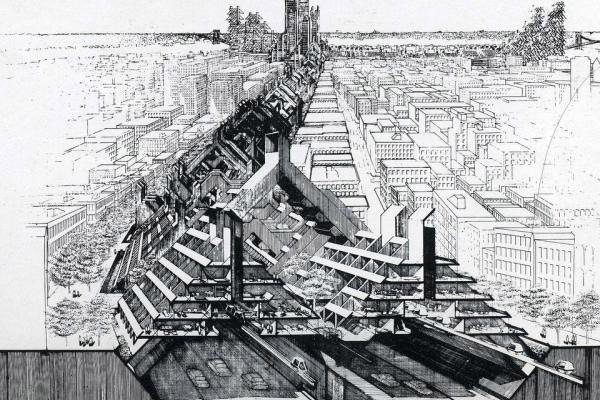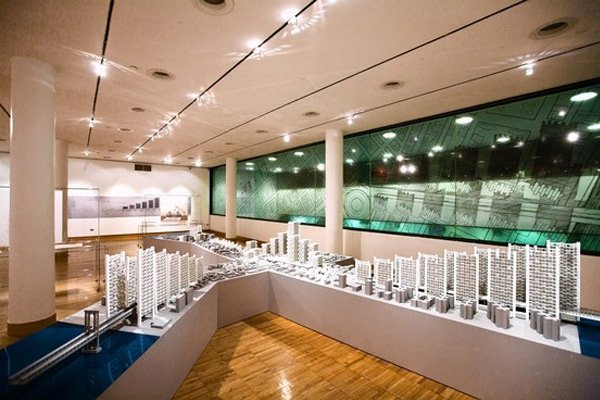Dec 18th in NYC History - the Birth, Rise and Fall of Robert Moses and the Tour Guides that defeated the greatest builder in history
Posted: Dec 17, 2012 | 8:34 PM
1839: NYU Professor John Draper daguerreotypes the moon, the first space photograph. He was part of a golden age of NYU science greats, including Professors Colt (revolver) and Samuel Morse.

1888: Robert Moses, the colossus of public works, was born. He lived until 1981.
He was probably the greatest master builder in history, including the ancient Romans, Egyptians and the Chinese.
At the height of his career he was simultaneously in charge of a dozen New York City and New York State agencies, creating hundreds of parks, including Jones Beach, the next great parks models since Vaux and Olmsted.
Moses built power dams, highways, the longest and tallest bridge in the world, the Verazanno, the Triborough Bridge, Lincoln Center, Shea Stadium, public housing, and much more.
He started out as an idealistic reformer helping rid the city
government of Tammany Hall's century-plus era of corruption in public works. He was so beloved for his wholesome gorgeous works, such as charming Jones Beach, connected by Parkways, parks you drive through. His power and responsibilities and achievements increased exponentially until he lost touch with whom these projects were for and whom they ruined. He took the 'you can't make an omelet without breaking a few eggs' approach to the furthest limits.
I have much more about Robert Moses below. His achievements merit consideration and debate, yet they still impact America and the world, since they are a model for what to do, and what not to do.
Happy Birthday, actor Ray Liotta (1955)! I don't know if he's a New Yorker (and I'm not going to check right now), but he was great in Goodfellas, the first mob movie I liked, and it took place in NYC.
1956: A year after retiring from the Yankees as a star shortstop Phil Rizzuto returns to baseball as a broadcaster for Yankee Games, which he'll do for the for the next 40 years.
1968: Chitty, Chitty, Bang, Bang premiers in NYC.
Happy Birthday, singer Christina Aguilera (1980)!
1987: Ivan Boesky, convicted of insider-trading, sentenced to three years in prison. Convictions have a way of changing behavior. Something to consider for the the world of finance's behavior the last fourteen years.
1992: Mark Goodson, Game Show Producer, died. He was born in 1915.
2006: Television Animator Joseph Barbera died. He was born 1911. His television cartoons were the best produced probably. While the animation was a step down from film cartoons, the characters and the writing was good. I suspect that the Flintstones writers were drunk while on tight deadlines.
More about ROBERT MOSES:

Robert Moses wanted the Lower Manhattan Expressway since the 1940s. Looking from Hudson to East River Bridges.
Although he couldn't drive himself (he had a chauffeur for his rolling office that he didn't look out of), Moses never envisioned a highway possibility he didn't like. He was a master at getting federal funding for highways and public housing, both of which led to a white and middle-class flight to the suburbs after World War 2.
Moses also had bias against the low-income and blacks, using his
low-bridged Parkways as a filter against public transit reaching his white peopled and white sand State Park beaches.
Later, his expressways flew over decaying neighborhoods festering below the highways which bisected them. Entire neighborhoods, social fabrics and local economies were razed, and replaced with public housing or elevated highways.
Moses created filters to keep low income people on the edge of city parks. He located public housing as far from the center of the city as he could, such as on Ave D on the East River, separating the Lower East Side from the East Side, Coney Island, or Red Hook at the extremes of Brooklyn. All three such projects were hard hit by Super Storm Sandy in 2012.
Ironically, this waterfront property with its light and views would be hugely valuable real estate now, if it were developed soundly.
Initially, the housing projects in the LaGuardia - FDR and Eleanor Roosevelt era were low-rises and family-oriented, but they grew, through 'urban renewal,' to dozens of stories of tall warehouses for the poor, like minimum security prisons without any security.
The surrounding blocks decayed as blocks upon blocks were demolished to make way for massive housing projects. It took over fifty years for some neighborhoods to recover. 650,000 New Yorkers live in public housing.
The elevated highways were great works of traffic engineering, overpassing New York City's snarled streets, but also putting communities under shadows, thumping tires, dust, pollution, asthma, broken glass, and being left behind economically, as the people with money whizzed above.

Lower Manhattan Expressway (LoMEx) contemporary urban studies rendering of what could have been. Had Little Italy and SoHo had been cut through. I think this rendering is kind. I think that SoHo would have decayed and been demolished, replaced with 1950s brick boxes.
Moses' first defeats happened in Brooklyn Heights and Lower Manhattan.
I would love to take you on a Brooklyn Heights walking tour after a Brooklyn Bridge tour.
Moses' vision was for the Brooklyn Queens Expressway (BQE) to slash across the western part of the neighborhood. Some historic and charming houses, some from the late 18th and early 19th centuries were destroyed. Many more were on the chopping block. The expressway was going to have an entrance ramp to the Brooklyn Bridge cutting through Hicks Street, the center of Brooklyn Heights. Had this plan been enacted, Brooklyn Heights would be a noisy, smelly, polluted place not worth as much visiting on foot, or living there.

Hicks Street in spring. This was going to be an elevated highway.
Bounding Brooklyn Heights is Moses' ugly Brutalistic urban
renewal behemoths on Cadman Plaza. While touring past there it is hard to convince passengers that just behind those massive buildings is one of America's loveliest charming enclaves.
What saved it? How was mighty Moses defeated? Tour guides!
Thanks to weekly consciousness-raising tours given by volunteer tour-guides from the Municipal Art Society in the early 1960s, Brooklyn Heights was the first New York City neighborhood that was landmarked. Thanks to this public attention, the buildings improved and families moved in and stayed, and the artists, writers and sailors and their adult entertainers moved out to more affordable neighborhoods, or the successful writers like Norman Mailer stayed.
Now Brooklyn Heights is quiet and leafy. It is one of the world's greatest collections of Victorian townhouses, especially
brownstones.
The BQE was cantilevered under Brooklyn Heights, above the Brooklyn waterfront. This engendered the Promenade, one of New York City's favorite parks and places, and a national model of responsible highway development. You can hardly notice the traffic and pollution.
On the other hand, the BQE there is nearly impossible to repair or upgrade. Also the entrance ramp to the Brooklyn Bridge from the area was not built. To this day, it is a confusing mess to get your car onto the Brooklyn Bridge. So Moses wasn't nuts. From a traffic engineering perspective, it makes sense to cut through those old buildings and streets clogging up efficient traffic flow.

The tall things near the bridges are huge Brutalist projects by High Modernist Paul Rudolph, whom I love, but whose municipal projects in Boston and Goshen City Halls are hated by locals. Many Rudolph projects have been and are threatened with demolotion.

Rudolph's developments would be higher than the 19th Century bridges. The hubris of High Modern Architecture.

Another defeat for the Master Builder was the LoMEX, pictured above.
The Lower Manhattan Expressway, which was mostly an elevated highway from two East River Bridge Bridges across to the Holland Tunnel to New Jersey. Not only were entire swathes through neighborhoods going to be hacked to make way for this overpass, but hugeurban renewal (1950s style) buildings would be built along the highway.
The message being: the past is a failure and the highway is the
perfect future leaving the old city and its problems underneath while you fly across it towards somewhere nicer, like another suburb.
SoHo (not named that then -- it was Hell's Hundred Acres!) was largely abandoned, and the highway was going to raze it.
Another heroic tour-guide, Margot Gayle, led tours showing how special the area is. She used magnets sticking to the columns to demonstrate that this is really a treasure: the cast iron district. Magnets don't stick to plaster, rotting wood, or cheap stone.
Abstract Expressionist and Pop Artists and some pioneering galleries specializing in Pop Art were able to stay in in the area, which was finally preserved in 1973.
I remember visiting SoHo in 1978 with my Mom, and the energy was exciting. I thought my mom was nuts; "let's go to SoHo." It sounded so weird.
Where the artists and galleries grow, then come the restaurants and boutiques. Now it has Prada, but the artists and galleries have moved to more affordable post-industrial spots.
The SoHo/Cast Iron District is one the most attractive shopping
districts in the world. Basically, it is a municipally managed (publicly paid for) outdoor mall with really good historic architecture, hearkening back to the era when those streets hosted the world's first department stores, with attractive window displays, using lighting, spurring consumption, and changing retail across planet earth.
Driving all this was nearby sweat shops, cheap labor making the world's first ready-made clothes. The garment industry was the number one employer of New Yorkers for about 100 years, and NYC was not just the fashion capitol, but the manufacturing capitol. The legacy of these factories' unions is felt today with fire safety, labor rights, and New Deal programs that have saved and are saving millions of lives. I love going on tour to Chinatown, Little Italy, and SoHo.
Greenwich Village, was a related defeat was Moses' vision for
the 5th Ave exit of the LoMEX, which would pass through LaGuardia place and land onto Washington Square Park to Fifth Avenue.
Nowadays, Washington Square Park is able to be the heart and soul of Greenwich Village, as well as the birthplace of the Folk Music revolution and its biggest star and turncoat, the chameleonic Bob Dylan, bard of the 1960s generation.
Preserving Washington Square Park led to the emergence of some pretty formidable local ladies, Jane Jacobs, and Doris Diether, who still, in her 80s, serves on Community Board 3 of
Greenwich Village as the doyenne of the Landmarks Committee. They changed urban planning from "Progress" to mixed use, considering 'the ballet of the sidewalks.'
Moses' legacy on New York City, New York State, and as a model for the development of highways, parks, cities and
suburbs across the United States and the globe is still felt for better and for worse.